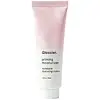What's inside
What's inside
 Key Ingredients
Key Ingredients

 Benefits
Benefits

 Concerns
Concerns

 Ingredients Side-by-side
Ingredients Side-by-side

Water
Skin ConditioningCaprylic/Capric Triglyceride
MaskingCetearyl Alcohol
EmollientNiacinamide
SmoothingPropanediol
SolventCitrullus Lanatus Fruit Water
Skin ConditioningSodium Stearoyl Glutamate
CleansingPisum Sativum Peptide
Skin ConditioningAcetyl Hexapeptide-1
Skin ConditioningIsopropyl Palmitate
EmollientSodium Hyaluronate
HumectantAcetyl Tetrapeptide-5
HumectantBiotinoyl Tripeptide-1
Copper Tripeptide-1
Skin ConditioningCaffeine
Skin ConditioningLeuconostoc/Radish Root Ferment Filtrate
AntimicrobialSqualane
EmollientLecithin
EmollientButylene Glycol
HumectantEthyl Acetate
PerfumingCyclohexane
SolventAcrylates/C10-30 Alkyl Acrylate Crosspolymer
Emulsion StabilisingSodium Hydroxide
BufferingLactic Acid
BufferingPhenoxyethanol
PreservativeBenzyl Alcohol
PerfumingWater, Caprylic/Capric Triglyceride, Cetearyl Alcohol, Niacinamide, Propanediol, Citrullus Lanatus Fruit Water, Sodium Stearoyl Glutamate, Pisum Sativum Peptide, Acetyl Hexapeptide-1, Isopropyl Palmitate, Sodium Hyaluronate, Acetyl Tetrapeptide-5, Biotinoyl Tripeptide-1, Copper Tripeptide-1, Caffeine, Leuconostoc/Radish Root Ferment Filtrate, Squalane, Lecithin, Butylene Glycol, Ethyl Acetate, Cyclohexane, Acrylates/C10-30 Alkyl Acrylate Crosspolymer, Sodium Hydroxide, Lactic Acid, Phenoxyethanol, Benzyl Alcohol
Water
Skin ConditioningCaprylic/Capric Triglyceride
MaskingPropanediol
SolventSqualane
EmollientBehenyl Alcohol
EmollientCetyl Alcohol
EmollientGlycerin
HumectantSorbitan Stearate
EmulsifyingPseudozyma Epicola/Camellia Japonica Seed Oil Ferment Extract Filtrate
Emulsion StabilisingSodium Hyaluronate Crosspolymer
HumectantAloe Barbadensis Leaf Juice
Skin ConditioningBuddleja Officinalis Flower Extract
UV FilterPoria Cocos Extract
Skin ConditioningPhragmites Communis Extract
Skin ConditioningTocopheryl Acetate
AntioxidantBetaine
HumectantSucrose Cocoate
EmulsifyingEthylhexylglycerin
Skin ConditioningHydroxyethyl Acrylate/Sodium Acryloyldimethyl Taurate Copolymer
Emulsion StabilisingMicrocrystalline Cellulose
AbsorbentCellulose Gum
Emulsion StabilisingPolysorbate 60
EmulsifyingSorbitan Isostearate
EmulsifyingTrisodium Ethylenediamine Disuccinate
Potassium Sorbate
PreservativeSodium Benzoate
MaskingPentylene Glycol
Skin ConditioningCitric Acid
BufferingWater, Caprylic/Capric Triglyceride, Propanediol, Squalane, Behenyl Alcohol, Cetyl Alcohol, Glycerin, Sorbitan Stearate, Pseudozyma Epicola/Camellia Japonica Seed Oil Ferment Extract Filtrate, Sodium Hyaluronate Crosspolymer, Aloe Barbadensis Leaf Juice, Buddleja Officinalis Flower Extract, Poria Cocos Extract, Phragmites Communis Extract, Tocopheryl Acetate, Betaine, Sucrose Cocoate, Ethylhexylglycerin, Hydroxyethyl Acrylate/Sodium Acryloyldimethyl Taurate Copolymer, Microcrystalline Cellulose, Cellulose Gum, Polysorbate 60, Sorbitan Isostearate, Trisodium Ethylenediamine Disuccinate, Potassium Sorbate, Sodium Benzoate, Pentylene Glycol, Citric Acid
 Reviews
Reviews

Ingredients Explained
These ingredients are found in both products.
Ingredients higher up in an ingredient list are typically present in a larger amount.
This ingredient is an emollient, solvent, and texture enhancer. It is considered a skin-softener by helping the skin prevent moisture loss.
It helps thicken a product's formula and makes it easier to spread by dissolving clumping compounds.
Caprylic Triglyceride is made by combining glycerin with coconut oil, forming a clear liquid.
While there is an assumption Caprylic Triglyceride can clog pores due to it being derived from coconut oil, there is no research supporting this.
Learn more about Caprylic/Capric TriglyceridePropanediol is an all-star ingredient. It softens, hydrates, and smooths the skin.
It’s often used to:
Propanediol is not likely to cause sensitivity and considered safe to use. It is derived from corn or petroleum with a clear color and no scent.
Learn more about PropanediolSqualane is an emollient that helps the skin hold onto moisture. It's an oily liquid that occurs naturally in certain types of fish and plant oils.
Because squalane boosts hydration in the skin, it also comes with plenty of benefits: it is an antioxidant and can help fight free radicals and skin damage. Squalane is also found to have a detoxifying effect when applied.
Squalane comes from squalene, which occurs naturally within the sebum of our skin. It is one of the oils our skin produces to keep itself hydrated. Squalane is the hydrogenated version of squalene and has a longer shelf life.
Research shows that squalane is non-irritating (even at 100% concentration).
In general, it's a fantastic ingredient. It does a great job at hydrating the skin, and it's suitable for those with sensitive skin.
The source of squalane may impact malassezia / fungal acne. This is because olive oil derived squalane can contain impurities such as fatty acids and plant waxes. Sugarcane derived squalane is recommended for anyone with malassezia concerns.
Is squalane vegan?
This depends on the source. Squalane can be derived from both plants and animals. Most squalane used in skincare comes from plants.
Please note: the source of squalane is only known if disclosed by the brand. We recommend reaching out to the brand if you have any questions about their squalane.
Read more about squalene with an "e".
Is squalane an oil?
Squalane is often called an oil, but it’s technically not; it’s a hydrocarbon, meaning it’s only made of carbon and hydrogen, unlike true oils which are triglycerides made of fatty acids and glycerol.
The term “oil-free” isn’t regulated, so companies can define it however they want. Some exclude all oils, while others just avoid mineral oil or comedogenic oils.
While some people avoid oils thinking they cause breakouts, the right kind of oil (or oil-like ingredient like squalane) can actually help balance and hydrate your skin. It’s worth testing out simple oils or squalane to see what works best for your skin.
Learn more about SqualaneWater. It's the most common cosmetic ingredient of all. You'll usually see it at the top of ingredient lists, meaning that it makes up the largest part of the product.
So why is it so popular? Water most often acts as a solvent - this means that it helps dissolve other ingredients into the formulation.
You'll also recognize water as that liquid we all need to stay alive. If you see this, drink a glass of water. Stay hydrated!
Learn more about Water